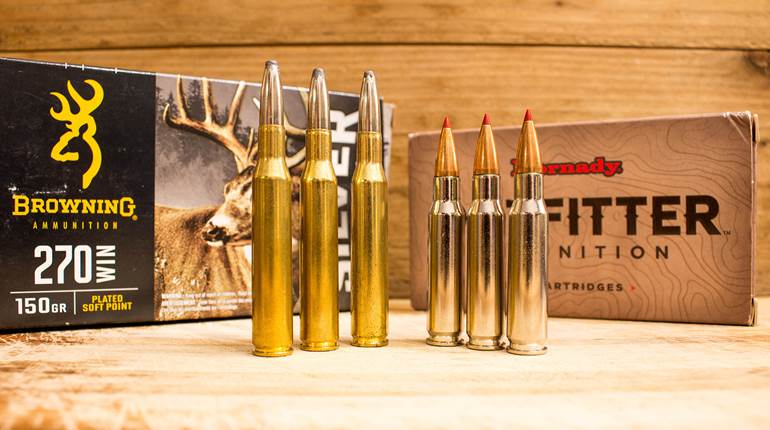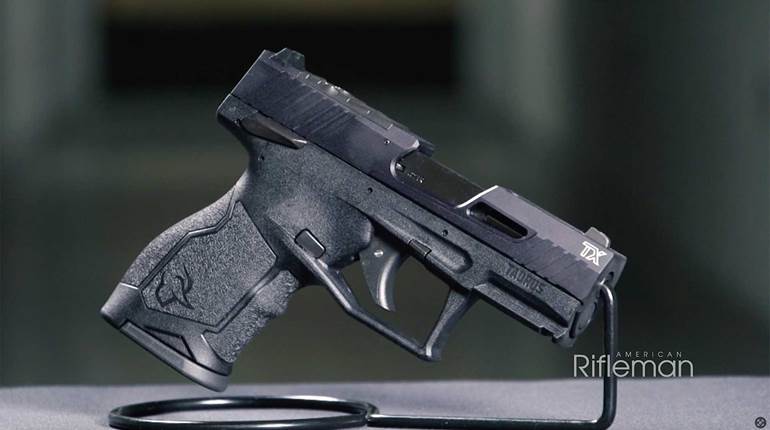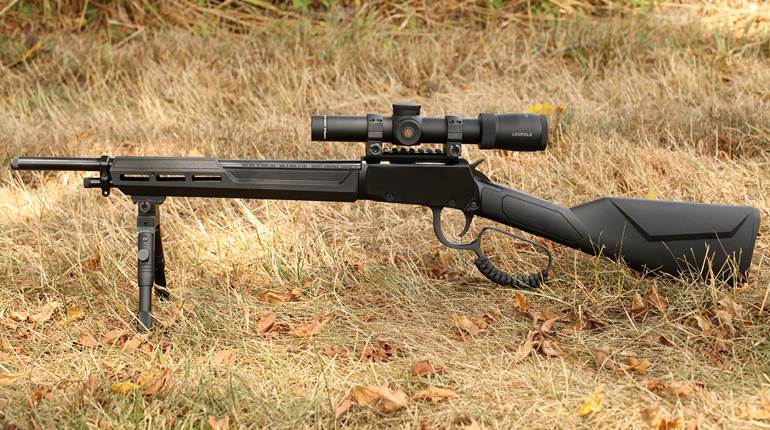
A shooter of smaller stature, Ann Marie Haviland can still handle about a dozen shots of .270 Win. off a bench from the Savage Model 110 Ultralite thanks to its effective recoil pad.
I must move within social circles with those who are cognizant of effective ballistics, because hunters regularly tell me that their main big-game rifles are chambered in .270 Winchester. Last week, a 19-year-old college football defensive end said he has grand hunting plans for the .270 he recently bought. This week, an 83-year-old retired doctor said his elk rifle for more than 50 years has been a .270. He did say that the hills seem steeper with every passing season, but added that his .270 never weighs him down. These hunters, and untold thousands of others, who are carrying .270 Win. rifles across plains and up mountains are in good stead as they pursue game. And handloading provides users of this uniquely American cartridge with a variety of options, allowing them to switch loads in order to occasionally hunt varmints and predators, while also being ready to pursue deer, antelope and larger game come fall.
Projectiles
The 130-gr. bullet is the original and standard weight for the .270 Win. It was initially made with a lead core surrounded with a copper-alloy jacket and an exposed lead tip to initiate expansion. Nearly a century ago, when the .270 was introduced, bullet designers didn’t give much thought to measuring a hunting bullet’s ability to overcome air resistance in flight, its ballistic coefficient (BC). Bullets for the .270 today have significantly improved and proliferated with designs to hunt all manner of game.

A .270 generates just enough recoil to become unpleasant after shooting 20 or so rounds. But the .270 Win. does make a decent small-game cartridge for occasionally anchoring marmots and ground squirrels while remaining adept when shooting in field positions. The Speer 90-gr. TNT bullet is a typical varmint bullet constructed with a thin jacket and flutes along the nose so that the bullet fragments upon impact. This bullet can be fired at velocities upwards of 3600 f.p.s. Most .270s, however, wear a relatively low-power variable scope, such as a 3-9X, and even set on the highest power it’s difficult to exactly place the crosshairs on a ground squirrel much past 250 yds. However, at a slower speed of 3200 f.p.s. and the TNT hitting 1.5" above aim at 100 yds., the trajectory is flat enough that aiming right on the little varmints out to 275 yds. will knock them off their mounds.

The best conclusion to a hunt I’ve ever seen occurred during one of my son’s stalks with a .270. Paul crawled toward the antelope and sat up when he was about 275 yds. from the buck. In one motion he braced his .270 on his upraised knees, brought the rifle to bear and fired. The rifle rose in recoil, and the buck collapsed in the same instant. The Nosler 130-gr. Ballistic Tip Paul used is an extreme expanding bullet with a plastic tip that slams back into the lead core on contact with game at velocities as slow as 1800 f.p.s. A thick rear jacket and base halt expansion, and there is no deadlier bullet for hunting antelope.
If the urge to shoot long distance possesses you, there are several .270 bullets with a high BC. Sierra’s 140-gr. Tipped GameKing has a G1 BC of 0.508, and Nosler’s 150-gr. AccuBond Long Range has a 0.591 BC. They compare favorably to 130-gr., .26-cal. bullets and 150-gr., .28-cal. bullets.
A good case can be made that a single-metal bullet, such as the Hornady 130-gr. GMX, is the perfect all-around bullet for the .270. Grooves around the gilding-metal GMX reduce bearing surface to decrease pressure and fouling. Along its path through game the GMX expands to nearly an inch in diameter. The expanded nose peals back alongside its shank to lessen frontal area and deeply penetrate.

The .270 Win. has never been considered a target cartridge. In no way, though, has this diminished its popularity, as there are more deer hunters in two counties in Pennsylvania than all the rifle target competitors in the nation. A Savage Model 110 Ultralite, used to shoot the .270 loads in the accompanying load table, hit the bullseye on my first attempt to develop a target and practice load with the rifle, shooting a 0.66" five-shot group with Sierra 135-gr. BTHP MatchKing bullets paired with IMR 4350 propellant. Subsequent groups did open up somewhat over a long string of shots.
Propellants
The amount and type of propellant the .270 burns approach the borderline of requiring magnum primers. Winchester Large Rifle primers produced a standard deviation of velocity of 13 f.p.s. firing 15 Nosler 130-gr. Ballistic Tips paired with 58.0 grs. of extruded Hodgdon H4831. Standard deviation was much higher at 39 f.p.s. shooting 15 Hornady 130-gr. GMXs loaded with 55.0 grs. of Hunter propellant and fired by Winchester primers; however, the deviation dropped to 11 f.p.s. after switching to Federal 215 Large Rifle Magnum primers. Velocity remained essentially the same with both primers and accuracy was similar.

Handloading the .270 Win. is a straightforward process. Case body taper of a .270 case is about three times that of some new cartridges, such as the 6.5 mm Creedmoor. Cases stretch little after they have been fired, partially full-length sized and then had their shoulders set back 0.002" to 0.003" for a close fit in the chamber. Experimenting with bullet-seating depths may improve accuracy. A fine bullet-seating depth is 0.050" from contacting the start of the rifling, which is close to the overall cartridge length stated in handloading manuals. That amount of bullet jump before contacting the rifling worked out fine for the Savage.
A fellow at the range a few weeks ago was conducting just such a bullet-seating experiment with the Remington Model 700 in .270 Win. He said he had previously settled on propellants and charge weights for the several different bullets he was shooting, and was now testing various seating depths of the bullets to fine-tune the accuracy of his loads. By the looks of the tight groups on his targets, he had accomplished his load development and is ready to join the hosts of others still putting the .270 Winchester to good use.





































